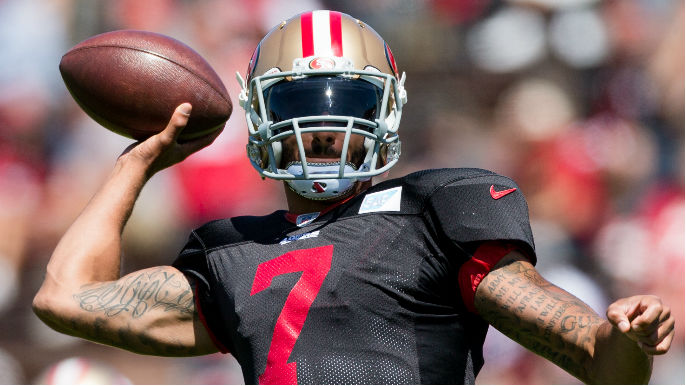The curious case of Colin Kaepernick’s arm fatigue in his right shoulder now extends to its fourth day. How it happened, and who is at fault for the injury is a discussion worth having.
“His throwing shoulder, just from the accumulation of what we’ve been doing, is a little sore,” Chip Kelly said. “It’s up to (Colin) to talk about his full medical disclosure. It’s not fair for me to do that.”
“(We) want to make sure that we’re staying ahead of things,” Kaepernick said. “I’m not going to get too much into my medical.”
Kaepernick has not been able to throw a football since Thursday, and when he missed Sunday’s preseason opener against the Texans, it evoked flashbacks of the quarterback’s checkered injury history. Kaepernick said he’s dealt with this soreness before as a baseball pitcher and he’s been icing it regularly. The 49ers are listing him as a day-to-day.
But shoulder injuries post-surgery, regardless of it being a different shoulder, can require more care than a few days rest. Kaepernick had his left shoulder operated on Nov. 24 after an extensive torn labrum, and also underwent surgeries on his right thumb and left knee in January.
Orthopedic surgeon and Duke professor Dr. Selene Parekh expressed some interesting thoughts about Kaepernick’s handling of his rehab process. Kaepernick originally began rehabbing with 49ers team doctors in December, but later nixed the organization in favor of a rehab program in Vail, Colorado.
“The concern is that he did not have an aggressive rehabilitation program where they really worked on his throwing mechanisms,” Dr. Parekh told KNBR.com. “The arm fatigue he is experiencing is likely due to deconditioning. This could takes weeks to fully heal.”
This adds up. Deconditioning is medically defined as losing fitness or muscle tone, especially through lack of exercise. Kaepernick told reporters he was scared to step on the scale after surgery, his weight was that low. The quarterback’s loss of muscle was apparent to the naked eye.
But Kaepernick is not the only party at fault. Dr. Parekh does not understand why the 49ers gave him an entire workload all at once.
“Think of it like this: you have a guy who works out all the time every day in the gym. He then takes three months off. The muscles he worked for so long start deconditioning. When he gets back into the gym, he can’t do the same amount of reps or weights or endurance,” Dr. Parekh said.
Kaepernick seemed to agree with Parekh’s diagnosis on Friday.
“You don’t really get the reps of live action and that violent motion when you’re practicing in the offseason,” Kaepernick said.
So even though the shoulder surgery wasn’t on his right arm, Kaepernick’s whole throwing process was impacted by going under the knife. Kelly said on Friday that both Kaepernick and Blaine Gabbert throw anywhere between 86 and 102 passes per day in training camp. A few months ago during OTAs in May, Kaepernick had barely resumed throwing short passes.
It’s unclear how much he threw during the month off from late June to late July, but Kaepernick’s workload increased exponentially from OTAs and was completely on par with a healthy Gabbert. There were no “limited days” for Kaepernick prior to last Thursday, something you generally see from NFL players coming off of multiple surgeries in training camp. The competitive Kaepernick likely approved of the 49ers’ plans to make him a full-go participant in training camp because he wanted to win the starting quarterback job, and because he probably wasn’t feeling pain at the start of training camp.
The 49ers will have to be careful if they expect Kaepernick to hop right back in the mix and resume an entire day full of 102 passes. Arm fatigue is not a career-threatening injury. Brett Favre, Tom Brady and Johnny Manziel, among many others, are quarterbacks who have experienced the chronic soreness.
But as Dr. Parekh stated, arm fatigue can take weeks of rest before it properly heals.
“I think the pain he’s experiencing is most likely due to lots of reps, and both shoulder muscles are just not ready for that type of work load.
“Obviously, this is without examining him. This is what I think is going on. The worst case scenario would be that he has some internal shoulder issues. Inflammation of the rotator cuff is a possibility,” Dr. Parekh said.
It’s too early to know how long Kaepernick’s arm fatigue will drag out. But we now know enough to realize that his right shoulder already has had a major impact on the quarterback competition.


